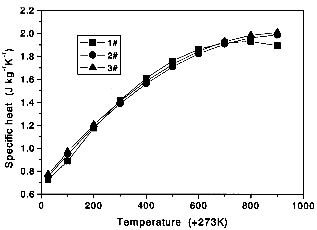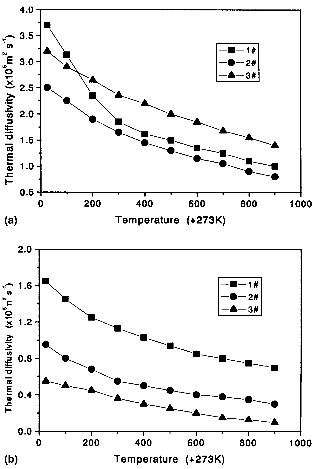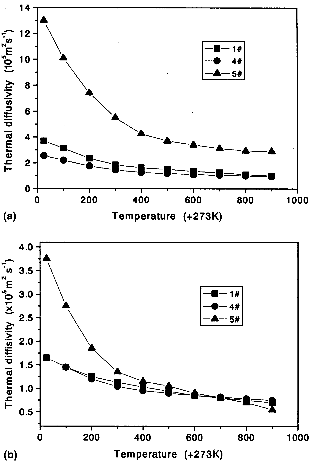Theoretically speaking, the TC of C/C composites is only dominated by three factors including the density ρ, specific heat c, and thermal diffusivity λ, Their product, namely α=λ*c*p, stands for the TC. For the five composites, their densities are close, and their specific heat increases with increasing temperature, shown in Fig.7,

fig.7-specific heat capacity of the 3 CC composites
which gives a positive contribution to the TC. That their specific heat is almost the same in the same temperatures implies that the preform architectures and the microstructures of the PyrC have little effect on it. Actually two ingredients in the C/C composites are all composed of carbon element. As long as the composite density does not differ too much, their specific heat will not make much discrepancy. Here their thermal diffusivity is worth to emphasize. The thermal diffusivity presents the performance of making the temperature uniform in the materials. In the X-Y and Z directions, the thermal diffusivity is shown in Figs.8 and 9. Their TC is an anisotropic property due to the anisotropy of the materials, and in a large extent, the TC is dominated by the thermal diffusivity.

fig.8-thermal diffusivity of the CC composites (a) X-Y direction (b) Z direction

fig.9-thermal diffusivity of the CC composites (a) X-Y direction (b) Z direction. same architectures.
For the C/C composites, the vibration of the crystal lattice is the source of heat conduction. According to the quantum theory, the crystal lattice vibration can be described by the phonon interaction. When the temperature is not too high, the energy of the optic phonon is small and can be ignored, so the energy transmission mainly depends on the acoustic phonon, which is regarded as the elastic wave interacting with the materials. Therefore the heat conduction is reasonably explained as the result of the phonon interaction, and the thermal diffusivity of the C/C composites can be expressed as
λ=A/c(ω)*ν*l(ω)*dω, (4)
where phonon velocity v is only related to the density and elastic mechanical performance of the composites, and because the C/C composites do not creep within 1000C it can be regarded as a constant. Their specific heat c and the phonon mean free path L are the functions of the phonon vibration frequency w. Phonon the interaction in the C/C composites is divided into three types: (1) phonon-phonon interaction; (2) phonon-defect interaction; (3) phonon-interface interaction, and in the phonon-phonon interaction, the mean free path is the most sensitive to temperature.